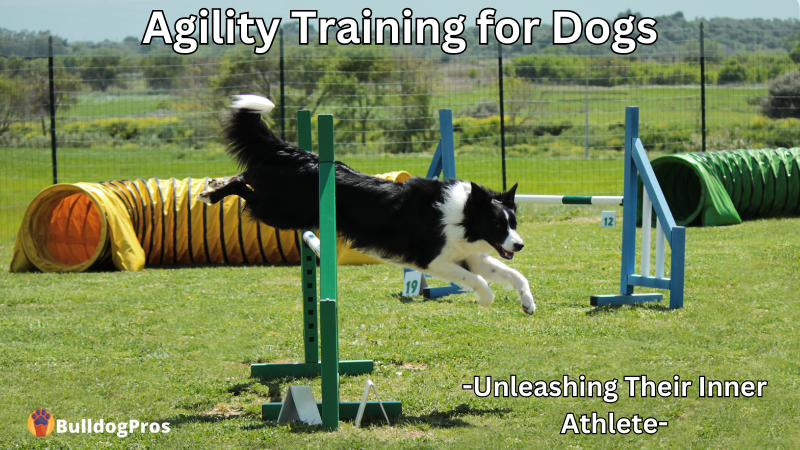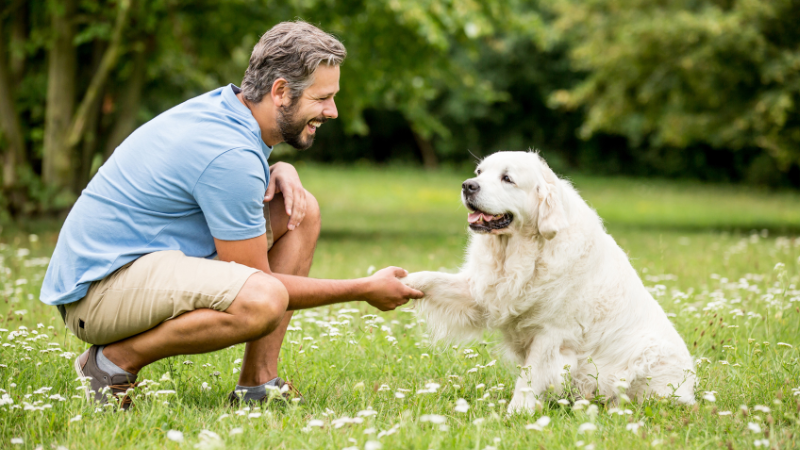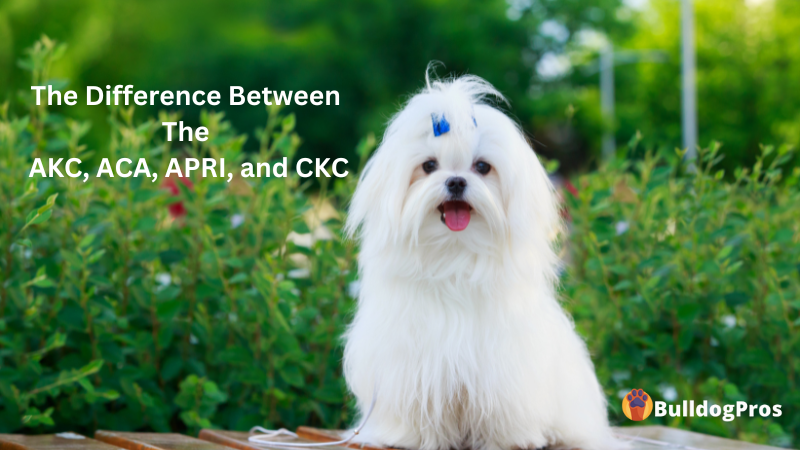Welcome to the thrilling world of agility training for dogs! If you’re a dog enthusiast like me, you know that our furry friends are natural athletes just waiting to shine. Agility training not only keeps them physically fit but also nurtures a stronger bond between you and your canine companion. In this guide, we’ll take you through the essential steps to get started and help your pup become an agile superstar.
What Is Agility Training For Dogs?
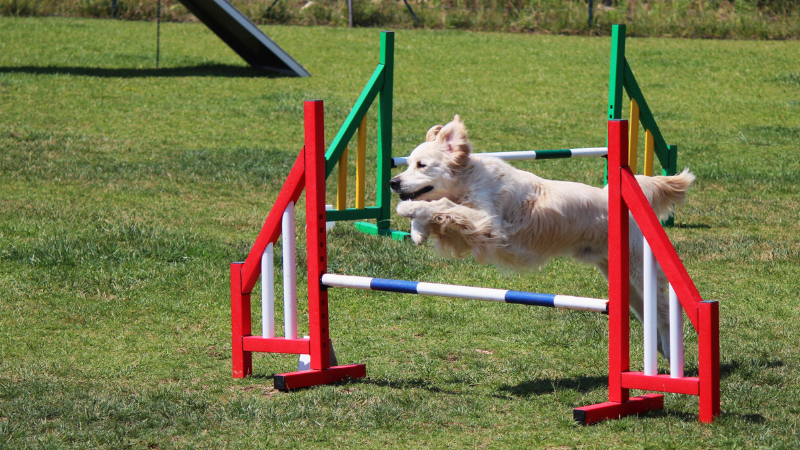
Agility training for dogs is an exhilarating and engaging canine sport that involves guiding your furry friend through a timed obstacle course. The goal is for your dog to navigate the course with precision, speed, and accuracy, showcasing their athleticism and obedience skills.
The agility course typically consists of a variety of obstacles, including jumps, tunnels, weave poles, A-frames, seesaws, and more. Each obstacle presents a unique challenge that tests your dog’s agility, coordination, and ability to follow cues from the handler.
In agility training, you and your dog work as a team. As the handler, you’ll guide your pup through the course, providing verbal and non-verbal cues to direct them along the correct path. The faster and more accurately your dog completes the course, the better their performance.
Agility training is not just a physical workout; it’s also a mentally stimulating activity for dogs. They need to think on their feet and make split-second decisions as they maneuver through the course. This mental challenge keeps their minds sharp and prevents boredom, making it a fantastic activity for both physical and mental enrichment.
What makes agility training even more special is the strong bond it fosters between you and your dog. The partnership and communication required during training sessions build trust and strengthen your relationship, creating a deeper connection that extends beyond the agility course.
One of the fantastic aspects of agility training is that it is suitable for dogs of all breeds, sizes, and ages. From high-energy herding breeds to laid-back companions, any dog can participate and enjoy agility training. However, it’s essential to ensure that your dog is in good physical health before beginning agility sessions.
Agility training can be done purely for fun and bonding with your dog, or you can take it to a competitive level by participating in agility trials and competitions. Regardless of your goals, agility training is a fantastic way to keep your dog active, engaged, and happy, all while building a strong and positive relationship with your furry companion. 🐾
Benefits of Agility Training
Agility training offers a wide range of benefits for both dogs and their owners. It’s a physically and mentally stimulating activity that can enhance the overall well-being of your furry friend. Here are some of the key benefits of agility training for dogs:
Physical Fitness: Agility training involves running, jumping, climbing, and weaving through obstacles, providing an excellent cardiovascular workout for your dog. It helps improve their endurance, strength, and overall physical fitness.
Weight Management: Regular agility sessions can aid in weight management, preventing obesity and its associated health issues. It keeps your dog active and burns calories, promoting a healthy body weight.
Mental Stimulation: Agility training challenges your dog’s mind as they navigate through the course, following your cues and making quick decisions. It provides mental stimulation, which is essential for keeping their minds sharp and preventing boredom.
Improved Coordination and Balance: Negotiating various agility obstacles requires precise movements and coordination. Through training, your dog learns to control their body and maintain balance, which can translate to improved coordination in daily activities.
Enhanced Bond with the Owner: Agility training involves working closely with your dog, building trust and strengthening your bond. It fosters a sense of teamwork and communication between you and your canine companion.
Confidence Building: As your dog masters each obstacle, they gain confidence in their abilities. This newfound self-assurance can positively impact their behavior and overall temperament.
Obedience Skills: Agility training reinforces basic obedience commands like sit, stay, and come. It improves your dog’s responsiveness to your cues, making them more obedient in various situations.
Socialization Opportunities: Participating in agility classes or competitions exposes your dog to new people, dogs, and environments. It provides socialization opportunities, helping them become more comfortable and well-adjusted in different settings.
Stress Reduction: Physical activity, mental challenges, and the joy of training can reduce stress and anxiety in dogs. Agility training can be a fun outlet for their energy, promoting a sense of relaxation and contentment.
Fun and Engagement: Dogs inherently enjoy problem-solving and physical activities. Agility training combines both, making it an enjoyable and engaging experience for your furry friend.
Competitive Opportunities: For those interested in taking agility to the next level, there are competitive opportunities available. Participating in agility competitions adds an extra layer of excitement and accomplishment for both you and your dog.
Getting Started with Agility Training
Before embarking on any agility training journey, it’s crucial to assess your dog’s physical condition to ensure they are ready for the challenges ahead. Just like any sport, agility training requires a certain level of fitness and flexibility to prevent injuries and ensure your dog’s well-being. Here are some essential aspects to consider when evaluating your furry friend’s readiness for agility:
Age and Health History
Age plays a significant role in agility training. While young dogs may have the energy and enthusiasm, puppies under one year old should avoid high-impact exercises to protect their growing joints. On the other hand, senior dogs might have more physical limitations and may require modified training techniques. Additionally, take note of any past injuries or health issues your dog has experienced, as these can impact their ability to participate in agility.
Weight and Body Condition
A healthy weight is crucial for agility training. Excess weight can strain joints and increase the risk of injury. Assess your dog’s body condition using visual and tactile indicators, such as feeling their ribs without excess fat cover. If your dog is overweight, consider a gradual weight management plan before beginning agility training.
Mobility and Flexibility
Observe your dog’s movement and flexibility. They should be able to move freely without any signs of stiffness or discomfort. Pay attention to how they walk, run, and jump, looking for any signs of limping or favoring one side.
Cardiovascular Fitness
Agility training requires bursts of intense activity, so your dog should have good cardiovascular fitness. If your dog gets easily winded during regular walks or play, consider gradually building their stamina before starting agility training.
Breed Considerations
Some dog breeds are better suited for agility due to their natural athleticism and agility. For example, Border Collies and Australian Shepherds are known for excelling in agility. While all breeds can participate, breeds with certain physical characteristics, like short-nosed brachycephalic breeds, may need modified training to prevent breathing difficulties.
Consult with a Veterinarian
When in doubt, consult with your veterinarian. A professional evaluation can provide valuable insights into your dog’s physical abilities and any potential limitations. They can offer guidance on training intensity and techniques tailored to your dog’s specific needs.
Tailoring Training for Different Breeds:
Understanding Individual Needs
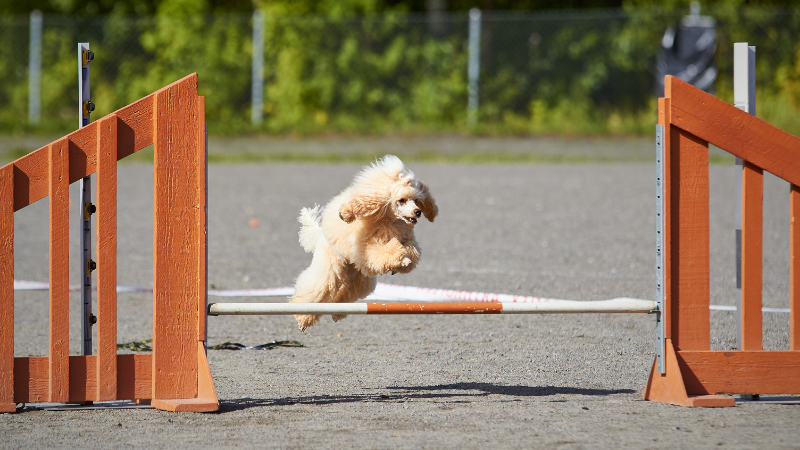
When it comes to agility training, it’s essential to recognize that different dog breeds have varying physical characteristics, temperaments, and strengths. Tailoring the training approach to suit each breed’s unique needs can significantly impact their success and enjoyment in agility. Here are some considerations when training different breeds:
1. Herding Breeds (e.g., Border Collies, Australian Shepherds): Herding breeds are known for their intelligence and high energy levels. They thrive on mental challenges and physical activities. Agility training is a natural fit for them, as it provides an outlet for their herding instincts and keeps their agile minds engaged.
2. Sporting Breeds (e.g., Labrador Retrievers, Golden Retrievers): Sporting breeds are typically eager to please and highly trainable. They excel in activities that involve retrieving and agility training provides a perfect opportunity for them to showcase their athleticism and enthusiasm.
3. Terrier Breeds (e.g., Jack Russell Terriers, Staffordshire Bull Terriers): Terriers are known for their tenacity and drive. They can be enthusiastic participants in agility, but their independent nature may require a bit more patience during training. Focus on building a strong bond and positive reinforcement to keep their attention.
4. Toy Breeds (e.g., Chihuahuas, Toy Poodles): Toy breeds are agile and light on their feet, making them surprisingly good candidates for agility training. However, take their small size into account and use appropriately sized equipment to ensure their safety and comfort.
5. Brachycephalic Breeds (e.g., Bulldogs, Pugs): Brachycephalic breeds have short noses and may be more prone to respiratory issues. Modify training to avoid excessive physical exertion and opt for exercises that prioritize their safety and well-being.
6. Mixed Breeds: Each mixed breed is unique, and their training should be tailored based on their physical attributes and behavioral tendencies. Observe their characteristics and adjust the training accordingly.
Regardless of the breed, positive reinforcement, patience, and consistency are essential in agility training. Celebrate your dog’s progress, no matter their breed, and adjust the training approach to suit their individual strengths and challenges. By understanding and accommodating each breed’s specific needs, you’ll create a rewarding and successful agility training experience for every dog. 🐾
Preparing the Right Training Environment:
Indoor vs. Outdoor Agility Courses
When it comes to agility training for dogs, the training environment plays a crucial role in shaping the overall experience. Both indoor and outdoor settings offer unique advantages, and the choice largely depends on factors such as weather conditions, available space, and your dog’s preferences. Let’s explore the differences between indoor and outdoor agility courses and the safety measures to keep in mind.
Indoor Agility Courses
Weather Protection
One of the main benefits of indoor agility courses is that they provide a controlled environment, shielded from the elements. Whether it’s scorching heat, heavy rain, or snow, your training sessions can continue uninterrupted, ensuring consistency in your dog’s progress.
Year-Round Training
Indoor facilities allow for year-round training, regardless of the weather outside. This means your dog can stay active and engaged even during the colder months, promoting continuous improvement in their skills.
Safety and Comfort
Indoor courses often have rubberized or padded flooring, offering better shock absorption and reducing the impact on your dog’s joints. This is particularly beneficial for dogs with joint issues or older pups who require extra care.
Outdoor Agility Courses
Natural Environment
Outdoor agility courses provide a more natural and visually stimulating setting for your dog. They get to experience various scents, textures, and sights, making the training sessions even more exciting.
Fresh Air and Sunshine
Outdoor training exposes your dog to fresh air and natural sunlight, contributing to their overall well-being and mental health. It can be invigorating and boost their enthusiasm during training.
Ample Space
Outdoor settings often offer more space for longer and more complex agility courses. This can be beneficial for advanced training and giving your dog the opportunity to reach higher speeds during runs.
Safety Measures for Agility Training:
Warm-Up and Cool-Down
Always begin each training session with a warm-up to prepare your dog’s muscles for exercise and reduce the risk of injury. Similarly, end with a cool-down period to help them gradually lower their heart rate.
Proper Footing
Whether indoors or outdoors, ensure the surface is free of hazards and provides adequate traction. Avoid training on slippery or uneven surfaces that may lead to slips or falls.
Age-Appropriate Training
Take your dog’s age and physical condition into account when designing the agility course. Puppies and senior dogs may require modified or gentler exercises.
Supervision
Always supervise your dog during agility training to ensure their safety and to provide immediate guidance if needed.
Positive Reinforcement
Use positive reinforcement techniques during training to encourage your dog and create a positive association with the agility course.
Building the Basics: Obedience Training – The Foundation of Successful Agility Training
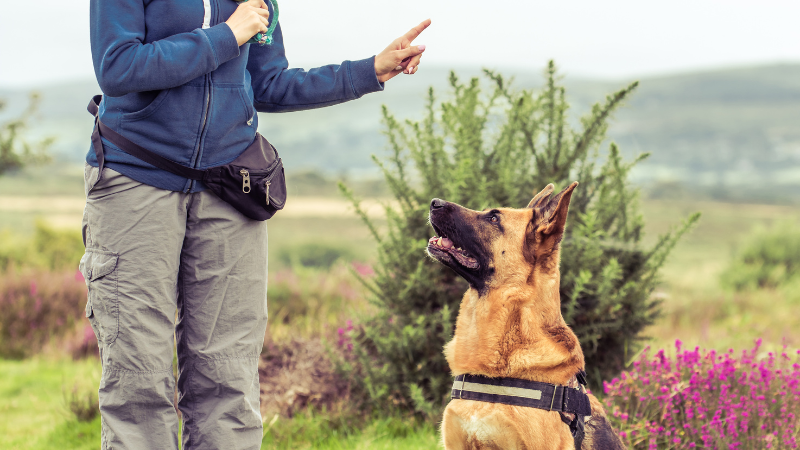
Obedience training forms the solid foundation upon which successful agility training is built. It’s not just about following commands; it’s about creating a strong communication bond between you and your dog, enabling seamless course navigation and flawless teamwork. Let’s delve into the key aspects of obedience training that will set your dog up for agility success:
Mastering Essential Commands
Before venturing into the agility course, revisit and reinforce essential commands like sit, stay, come, and heel. These fundamental cues lay the groundwork for off-leash control and focus, making it easier to guide your dog through the agility obstacles.
- Sit: Teach your dog to sit and hold the position until you release them. This command is invaluable for getting your dog’s attention and preparing them for the next challenge.
- Stay: A reliable stay command is essential for keeping your dog in place until you give the signal to move. This command prevents premature starts on the course and allows you to position yourself strategically.
- Come: The recall command is crucial for agility training, especially during off-leash sessions. Your dog should come to you promptly, even amid exciting distractions.
- Heel: Heel training ensures your dog walks calmly and closely by your side, fostering better communication and control during agility sessions.
Instilling Focus and Attention
In the fast-paced world of agility, maintaining focus and attention is paramount. Work on exercises that encourage your dog to look to you for guidance and remain engaged, even amidst the most exciting moments.
- Eye Contact: Teach your dog to make eye contact with you on command. Reward this behavior generously, as it creates a strong connection and encourages them to pay attention to your cues.
- Impulse Control: Incorporate impulse control exercises, like wait and leave-it commands, to teach your dog to resist distractions and maintain focus on the task at hand.
- Recall Games: Practice recall games in different environments, gradually increasing the level of distractions. This strengthens your dog’s responsiveness to the come command, even in high-energy situations.
Training Amidst Distractions
Agility courses can be filled with enticing stimuli that might challenge your dog’s focus. Gradually expose them to various distractions, such as toys, noises, or other dogs, while practicing obedience commands. This will help them stay focused and responsive during actual agility sessions.
Positive Reinforcement
Always use positive reinforcement during obedience training and agility sessions. Reward your dog with treats, praise, or play whenever they respond correctly to a command. Positive reinforcement builds enthusiasm for training and strengthens the bond between you and your canine athlete.
Remember, patience and consistency are key when building the basics of obedience training. Take small steps, celebrate every success, and keep training sessions short and enjoyable. With a solid foundation in obedience, your dog will approach agility training with enthusiasm and confidence, making the journey both rewarding and fulfilling for both of you. Together, you’ll conquer the agility course and celebrate each triumphant moment! 🐾
Essential Equipment for Agility Training
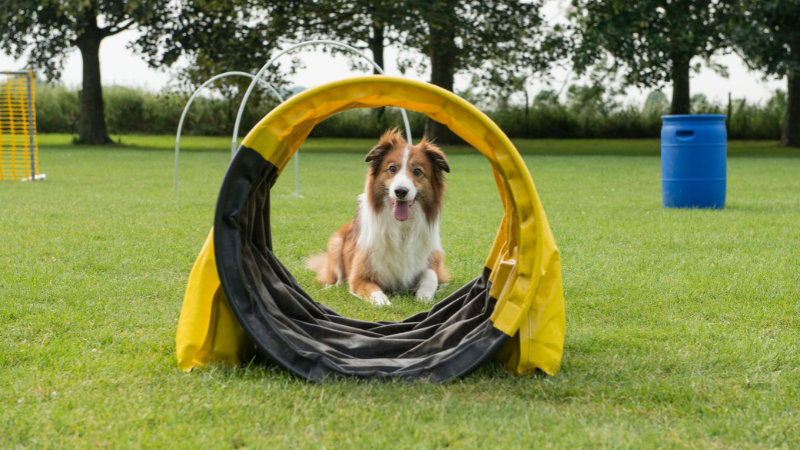
Agility training is all about mastering a series of thrilling obstacles, and having the right equipment is essential to create a fun and challenging course for your furry athlete. Whether you’re training at home or in a dedicated facility, here’s a rundown of the agility equipment to set your dog up for success:
Jumps
These are foundational agility obstacles, consisting of horizontal bars that your dog must clear. Adjustable jump heights allow you to cater to your dog’s skill level. Start low for beginners and gradually increase the height as they progress.
Tunnels
Dogs love the excitement of zooming through tunnels! These flexible fabric tunnels come in different lengths and shapes, and they help improve your dog’s confidence and agility as they navigate through the dark passageways.
Weave Poles
The weave pole challenge tests your dog’s weaving skills as they maneuver through a series of upright poles. Starting with just a few poles and gradually increasing the number will help your dog master this tricky obstacle.
A-Frame
The A-frame is a large, slanted obstacle that requires your dog to climb up one side and descend the other. It’s great for building your dog’s climbing confidence and enhancing their coordination.
Dog Walk
The dog walk is a narrow and elevated walkway with a ramp at each end. Your dog will demonstrate their balance and focus as they cross the walkway without falling off the edges.
Seesaw (Teeter-Totter)
The seesaw is an exciting moving obstacle that tilts as your dog walks across it. Teaching your dog to control the movement and balance on the seesaw is a significant achievement in agility training.
Pause Table
The pause table provides a designated spot for your dog to pause and collect themselves during the course. This obstacle allows them to reset and prepares them for the next challenge.
Contact Zone Equipment
Contact obstacles like the A-frame and dog walk have “contact zones” marked with colored areas at the bottom. Your dog must touch these areas with at least one paw to demonstrate control and safety during the descent.
Tire Jump
The tire jump is a hoop that your dog must jump through. It adds variety to the course and helps improve your dog’s jumping accuracy.
Treats and Toys
While not physical equipment, treats and toys are essential tools for motivating and rewarding your dog during agility training. Positive reinforcement keeps them engaged and eager to tackle each obstacle.
Introducing Your Dog To Agility Equipment
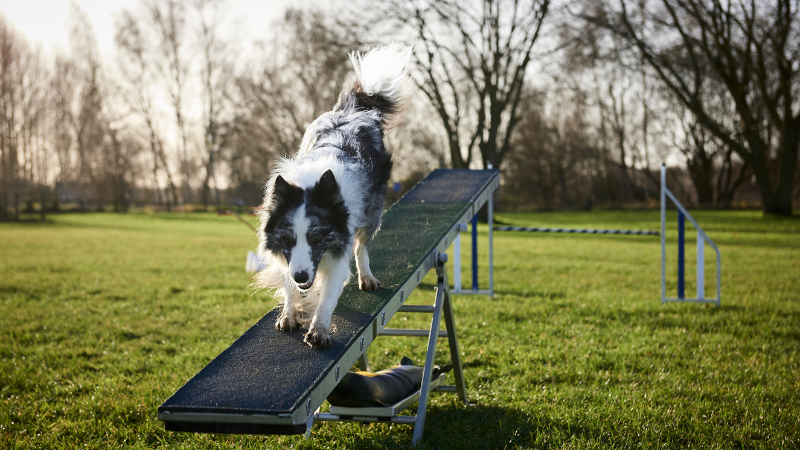
When introducing your dog to agility equipment, the key is to make it a positive and enjoyable experience. Start with a slow and gradual approach, keeping in mind that each dog learns at their own pace. Begin by allowing your dog to explore the equipment in a relaxed and familiar environment. Let them sniff and investigate the obstacles at their own comfort level without any pressure.
Next, use treats, praise, and toys to create positive associations with the equipment. For instance, place treats near the tunnel entrance or on top of a low jump to encourage your dog to interact with the obstacles willingly. As they start engaging with the equipment, shower them with praise to reinforce their positive behavior.
To build confidence, guide your dog through the equipment using verbal cues and gestures. Start with simple commands like “through” for tunnels and “jump” for low jumps. Gradually progress to more complex obstacles as your dog becomes more comfortable and confident.
Always be patient and understanding during the introduction process. If your dog seems hesitant or unsure, never force them to interact with the equipment. Instead, take a step back, continue with positive reinforcement, and try again later. With time, patience, and positive reinforcement, your dog will develop the enthusiasm and confidence needed to excel in agility training, turning the course into a playground of excitement and achievement for both of you. 🐾
Overview of Agility Training Techniques
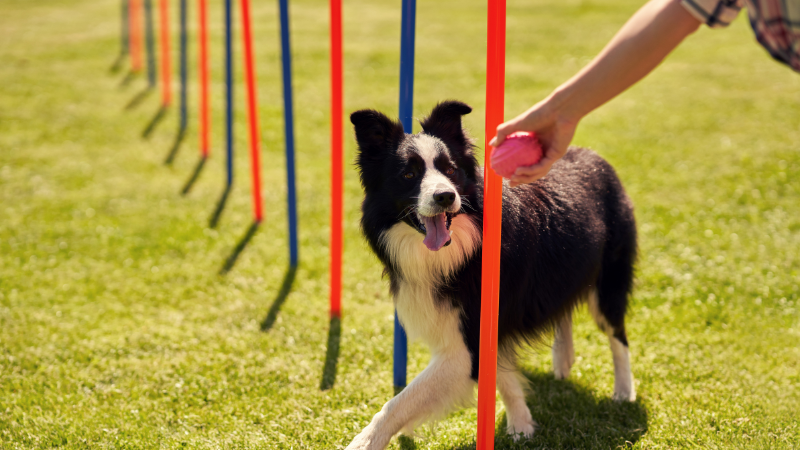
Here’s a brief overview of some agility training techniques to enhance your dog’s skills and performance on the course:
1. Jumping Technique: Teach your dog to jump over various obstacles, such as bars and hoops. Start with low jumps and gradually increase the height as your dog gains confidence and strength. Focus on proper form and technique, encouraging your dog to clear the jumps cleanly with good timing and coordination.
2. Tunnel Training: Introduce your dog to tunnels by using treats or toys to guide them through. Gradually lengthen the tunnels and add curves to increase the challenge. Teach your dog to confidently enter and exit tunnels on command.
3. Weave Pole Training: Teaching the weave pole technique involves guiding your dog through a series of closely spaced upright poles. Start with a few poles and reward your dog for weaving through. Gradually add more poles and reduce the distance between them as your dog becomes more skilled.
4. Contact Zone Training: Teach your dog to touch specific areas on contact obstacles like the A-frame and dog walk. Reinforce proper contact behavior to ensure safety and precision on these obstacles.
5. Teeter-Totter Training: Introduce your dog to the teeter-totter gradually, starting with a stationary board. Reward your dog for walking across. Increase movement slowly until your dog is comfortable with the seesaw motion.
6. Pause Table Training: Teach your dog to pause on the table for a designated time. Use treats or toys to keep them engaged and reward their patience.
7. Verbal and Non-Verbal Cues: Establish clear verbal and non-verbal cues for each obstacle. Consistent communication is essential for guiding your dog through the course effectively.
8. Sequencing and Course Work: Combine multiple obstacles into sequences or courses. Practice running these courses with your dog, gradually increasing the complexity. Work on your timing and positioning to lead your dog through the course smoothly.
9. Speed and Agility Drills: Incorporate speed and agility drills to enhance your dog’s quickness and responsiveness. Use games and exercises to make training sessions dynamic and engaging.
10. Positive Reinforcement: Throughout agility training, use positive reinforcement, such as treats, praise, and play, to motivate and reward your dog’s efforts and successes. Positive reinforcement creates a positive association with agility training and strengthens the bond between you and your furry companion.
Remember, agility training should always be enjoyable for both you and your dog. Keep training sessions fun, rewarding, and suited to your dog’s individual abilities and learning pace. With dedication and positive reinforcement, your dog will become a confident and skilled agility athlete, ready to conquer any course with enthusiasm! 🐾
The Art of Timing and Communication in Agility Training
Timing and communication are the pillars of successful agility training, fostering seamless coordination between you and your dog on the course. Developing a deep understanding of these elements is essential to achieve peak performance and a strong connection with your furry companion.
Timing
Timing in agility training refers to delivering cues and commands at the precise moment when your dog needs them. Reacting too early or too late can lead to confusion and affect your dog’s performance. Pay close attention to your dog’s movements and anticipate their actions to deliver cues with impeccable timing. Quick and clear signals help your dog navigate the obstacles efficiently and stay focused on the task at hand.
Verbal and Non-Verbal Communication
Agility training involves both verbal and non-verbal communication. Verbal cues, such as “sit,” “stay,” “come,” and obstacle-specific commands, guide your dog through the course. Non-verbal cues, like hand signals and body positioning, complement verbal cues and provide additional guidance. Consistent and well-established communication ensures that your dog understands your intentions and can respond promptly during high-speed agility runs.
Dog Agility Classes
Now, if agility training sounds overwhelming, there are agility classes you can take with your dog. That’s what I did, I didn’t have a clue. It was a fun experience. So if you think there is no way you would be able to teach your dog agility you might want to check out a class.
Agility training classes offer a vibrant and interactive environment for both dogs and handlers to dive into the exhilarating world of agility. These classes provide a structured and guided approach to learning the ropes of this thrilling sport. Here’s a glimpse into the world of agility training classes and their unique benefits:
1. Professional Instruction: Agility training classes are led by experienced trainers who possess in-depth knowledge of the sport. Their expertise ensures that you and your dog receive proper guidance and instruction, setting you on the path to success.
2. Skill Development: These classes focus on developing essential agility skills, such as jumping, weaving, tunnel work, and contact obstacles. Gradually, your dog will learn to navigate through complex courses with finesse and precision.
3. Building Confidence: In a supportive and encouraging class setting, dogs gain confidence in tackling agility obstacles. The positive reinforcement used by trainers helps dogs overcome fears and hesitations, empowering them to embrace new challenges.
4. Socialization and Distraction Training: Agility training classes provide an excellent opportunity for your dog to socialize with other dogs and handlers. Learning to focus amidst the distractions of a class environment strengthens their ability to perform well in real-life agility competitions.
5. Teamwork and Communication: Agility is a team sport, and training classes emphasize the importance of effective communication between you and your dog. Handlers learn to give clear cues, while dogs become adept at understanding and responding to their handlers’ instructions.
6. Tailored to Different Skill Levels: Agility training classes cater to various skill levels, from beginners to advanced handlers. This ensures that you and your dog receive customized training appropriate to your experience and abilities.
7. Fun and Bonding: Agility classes are packed with fun and excitement for both you and your furry friend. The joy of navigating courses and conquering obstacles together strengthens the bond between you, creating lasting memories.
8. A Supportive Community: Attending agility training classes introduces you to a community of fellow agility enthusiasts. This supportive network provides camaraderie, valuable insights, and a sense of belonging to the broader world of agility.
9. Advancing to Competitions: For those interested in competitive agility, training classes serve as a stepping stone. With proper guidance and skill development, you and your dog can confidently enter agility trials and showcase your abilities.
10. A Lifelong Journey: Agility training is a continuous journey of growth and learning. With each class, you and your dog progress together, achieving new milestones and celebrating shared successes.
Taking It to the Next Level: Competitions and Events in Agility
Competing in agility events can be an exciting and rewarding experience for both you and your dog. It allows you to showcase the hard work and training you’ve put in while enjoying the thrill of friendly competition with fellow agility enthusiasts. Here’s a brief overview of what to expect when taking your agility training to the next level with competitions and events:
Agility Trials: Agility trials are organized events where dogs and handlers compete on standardized courses, demonstrating their skills and speed in completing the obstacles. These trials are usually categorized based on skill levels, from novice to advanced, allowing dogs and handlers to compete with others of similar experience.
Course Variations: In competitions, courses are set up with different sequences and challenges. Handlers are given a course map before the run, allowing them to plan their strategy and cues. Each course presents unique challenges, requiring quick thinking and precise communication between you and your dog.
Judging and Scoring: Competitors are judged on their accuracy, speed, and how well they navigate the course. Points are awarded for successfully completing obstacles and following the correct sequence. The goal is to complete the course with the fastest time and the fewest faults.
Titles and Achievements: Successful completion of certain courses and earning specific scores can lead to earning titles, recognized by agility organizations. Titles represent various levels of accomplishment and reflect your dog’s proficiency in agility.
Event Atmosphere: Agility events are filled with camaraderie and enthusiasm. You’ll meet fellow agility enthusiasts, make new friends, and share experiences and tips with other handlers. The supportive and positive atmosphere makes competitions a fun and social experience for both you and your dog.
Nerves and Excitement: Competing in agility trials can be nerve-wracking, especially for first-timers. Remember to stay calm and focused, as your dog will pick up on your emotions. Trust in the training you’ve done together, and have confidence in your bond as a team.
Learning Opportunities: Participating in competitions provides valuable learning opportunities. Observing other handlers and watching runs can offer insights into different handling techniques and strategies. Embrace every experience as a chance to grow and improve.
Enjoy the Journey: Above all, remember that agility competitions are meant to be enjoyable for both you and your dog. Celebrate your successes, learn from any challenges, and cherish the journey of growth and bonding with your canine companion.
Participating in agility competitions and events can be a thrilling adventure that deepens your connection with your dog and allows you to celebrate your shared accomplishments. Embrace the spirit of friendly competition and continue to nurture your passion for agility training as you embark on this exciting chapter in your agility journey. 🐾
FAQs
Can any dog participate in agility training?
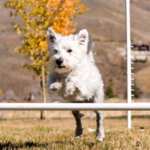
Yes, absolutely! Agility training is suitable for dogs of all breeds and sizes. From the tiniest Chihuahua to the largest Great Dane, any pup can participate and enjoy agility. However, it’s essential to ensure your dog is in good physical health and has completed basic obedience training before starting agility sessions.
How often should I train my dog in agility?
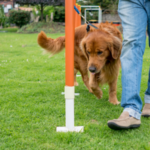
Consistency is key to successful agility training. Aim for short and frequent training sessions, ideally 2-3 times a week. Each session can last around 15-20 minutes, depending on your dog’s attention span. Remember to keep it fun and end on a positive note to keep your dog excited about the next training session.
How can agility training benefit my dog’s behavior?
gility training is not only physically demanding but also mentally stimulating for your dog. Engaging in regular training helps reduce behavioral problems like excessive barking and destructive behavior. It channels their energy in a positive way and provides an outlet for their natural instincts.
Additional Reading
Conclusion
In conclusion, agility training for dogs is an incredibly enriching and dynamic journey that brings joy, excitement, and a deeper connection between you and your furry companion.
Whether you aim to compete in agility trials or simply engage in agility for recreational fun, embrace the challenges, celebrate the victories, and savor the memories you’ll create with your furry friend.
With dedication, love, and a wagging tail, you and your dog will conquer the agility course and create cherished moments that last a lifetime. Happy training, and may your journey be filled with boundless joy and accomplishments! 🐾😊
Have you considered agility training for your dog? What are you thoughts or hesitation in doing so? Please comment below.
